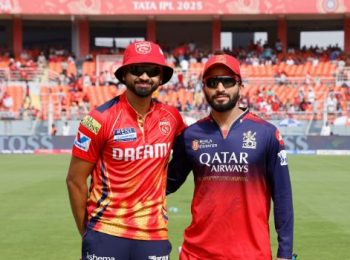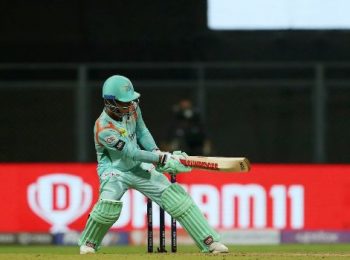On October 24, 2021 the pre-tournament favourites India were jolted by a ten-wicket thrashing at the hands of Pakistan to, for all practical purposes limp out of the T20 World Cup in the league stage. On November 10, 2022 the Indian cricket team exited this years’ T20 World Cup after a ten-wicket hammering by England. This time they had done well to reach the semi-finals, given the clear problems weighing down the team, but the insipid performance against England has left many wondering just what was achieved in the 12 months that separated these two ten-wicket defeats.
After India failed to qualify for the 2021 T20 World Cup semi-finals, Virat Kohli left the captaincy and in his place was appointed Rohit Sharma, the man who had led Mumbai Indians to five IPL trophies. The most successful IPL captain and a white-ball behemoth was entrusted with leading India into the next T20 World Cup in Australia, and along with the appointment of a new head coach in Rahul Dravid, who has achieved success with the Under-19 team in 2018 and then with various India A squads in his capacity as the head of the National Cricket Academy, there was hope of change and a revamped template because it was evident in the UAE last year that India were still playing an outdated brand of T20I cricket.
Alas, a year on, it does not seem like much has been gained. Barring the astounding rise of the phenomenon known as Suryakumar Yadav, the critical inclusion of rookie left-arm pacer Arshdeep Singh, the failed experiment with Dinesh Karthik as finisher and the injurt-forced absence of Jasprit Bumrah, the Indian squad wore almost the same look as the one that went to last year’s T20 World Cup. And once again the team’s campaign ended with a ten-wicket hammering. Some will say that this one hurts more than the defeat to Pakistan in 2021.
When the opposition smacks 170 runs in 16 overs without losing a wicket, something is clearly amiss. But this was not about one bad day by Rohit’s team. This was an accident waiting to happen. And here is why.
THE OPENERS’ STRUGGLES
Rohit and KL Rahul have had issues as a pair. All year, Rohit has played some aggressive cameos to underline the team’s mantra about needing to play more attacking cricket, after they struggled to put up good scores in 2021. But an improved strike-rate from Rohit did not entirely mask his inability to score sizeable innings, even though he did often contribute throughout the year to some good Powerplay scores. Because come this T20 World Cup, Rohit was a big failure. Six innings for 116 runs at an average of 19.33 and strike-rate of 106.42 is bad, but when you amplify the numbers to look at the first six overs, you see where India really shot themselves in the foot.
In the Powerplay overs, Rohit faced 76 balls, of which 42 were dots, from which he managed just 72 runs. That is a strike-rate of 94.73. Just not acceptable in T20I cricket, from an opener and that too one of Rohit’s immense skill and experience.
And his opening partner? Well, Rahul was worse. He scored 68 runs from 76 deliveries faced in the Powerplay block, which gives him an abysmal strike-rate of 89.47. But oh, we all know that Rahul believes strike-rates are over-rated, remember? For a batsman of Rahul’s talent, who for years has dominated the IPL run charts, to face 46 dot balls and strike at under 90 in a T20 World Cup is unfathomable. You do not win tournaments with such a conservative approach in the first six overs.
It has been pointed out all through this tournament that the conditions and quality of bowling has not aided free scoring inside the Powerplay and that it has been difficult to bat upfront. Well then, have a look at these numbers. These are the stats for the top six teams in the World Cup, in the Powerplay.
England scored at 8.6 runs an over in the first six, facing 78 dot deliveries. The next best was South Africa, who scored at 8.23 per over while facing 75 dots. Then came New Zealand (RPO 7.33, 81 dots) followed by Australia (RPO 6.7, 78 dots), Pakistan (RPO 6.47, 115 dots) and then India (RPO 6.02, 115 dots). It is clear as crystal that Rahul was just too timid in the Powerplay – he faced a maiden over in the match with Zimbabwe for his fifth such instance in T20Is – and Rohit never once looked comfortable. Both of Rohit’s two noticeable scores involved several chances. Where did all the talk of being aggressive go when India’s opener were so meek inside the Powerplay?
DEPENDENCY ON KOHLI AND SKY
What this approach did was put added pressure on Virat, Suryakumar and Hardik Pandya to score more runs and faster runs. It was expected given the bowling woes during the Asia Cup and after that India’s batting would have to step up in Australia, but to see just two players in Kohli (the tournament’s leading run-scorer) and Surya (who acquitted himself well in first tour of Australia) and to a lesser extent Pandya do all the heavy lifting was to wonder what this team got from its poor selection and rigid thinking in regards to their openers.
No doubt, the lack of runs from Rohit and Rahul’s conservative approach were factors in why India did not reach the final. It has been said before that there is no room for Rohit, Rahul and Kohli in this 11 and it was once more underlined. Kohli played the innings of his life against Pakistan and four fifties in six innings, and while you can argue about his strike-rate at times, the man finished the World Cup with 296 runs while striking at 136.40. Kohli can remain India’s anchor, and if need be he can be asked to open.
Surya dazzled with fifties against South Africa, Netherlands and Zimbabwe but failed, again, versus Pakistan and then in the semi-final when he faced just his fifth delivery of legspin all tournament. Pandya played a pivotal role in guiding Kohli and India to that tense win over Pakistan, and then stepped up against England with a dazzling half-century. But this dependency on these three batsmen shows how flimsy India’s batting was.
MISGUIDED FAITH IN DK
Which brings us to Karthik’s role in this T20I setup. To my mind, there has never been a more outlined or precise selection in Indian cricket’s white-ball history. That is to say, no player has ever been picked – or recalled, in this case – with as specific a role as Karthik’s. After a super run for perennial play-off chokers Royal Challengers Bangalore in this year’s IPL, where he finished off innings and matches repeatedly, Karthik was recalled at the age of 36 with the exact job outline of being India’s finisher at the World Cup.
Hence he was played in almost every T20I match India played across six months, and trained for a very explicit role: to hit balls into the stands when there were only a couple of overs left in a match. In this high-risk role, where finishers stand to fail more than succeed, Karthik was backed unanimously by the team management.
In 19 innings from the time he was recalled and before the start of this World Cup, Karthik scored 273 runs at a strike-rate of 150.82. In this period, he faced more than 15 deliveries on just five occasions and the results were scores of 30* off 21 balls, 55 off 27, 12 off 17, 41* from 19 and 46 from 21. He failed in 10 innings, and in these there were six instances where Karthik’s strike-rate was less than 85 and as low as 66.66.
Clearly this was a struggling experiment, but India backed him for the World Cup while keeping Rishabh Pant out. Come the first match of the World Cup, against Pakistan at the MCG, and Karthik failed in the exact role and situation for which he had trained with this team for six months. He walked out in the last over and made one run from two balls, out stumped against the kind of bowling he has statistically struggled the most when facing: left-arm spin.
Then on that bouncy Perth surface, where South Africa’s pace attack had reduced India to 49/5 inside nine overs, Karthik was taken out of his familiar finisher’s role and asked to bat for time in the presence of Surya. Here too his vault of experience came up short, for he pottered about 15 deliveries for just six runs before a terrible shot saw him walk back. Then against Bangladesh, Karthik was run out for seven off five and was not played again.
How did the team management that backed him for 28 T20Is this year suddenly go back to Pant for India’s final league game and then the semi-final? What did the misguided faith in Karthik, aged 37 and recalled only with this World Cup in mind, ultimately get India?
A WEAK MIDDLE ORDER
All this time India were focused on Karthik as their finisher, they failed to locate other middle order options. A top four of Rohit, Rahul, Kohli and Suryakumar meant that no one could bat higher than five. Deepak Hooda, whose call-up to India’s squad was based on a strong IPL season where he batted at only No 3 and 4, was shunted down to five, six and seven when the preferred top four was reunited. Pant was tried and failed to use his chances. Shreyas Iyer was given a long rope and then dropped, Venkatesh Iyer was briefly tried and discarded, Sanju Samson was tried and also not persisted with and Ravindra Jadeja was used and looked a good bet until he inexplicably injured himself while ski boarding in Dubai during the Asia Cup. This chopping and changing on account of big players being rested left India with a shaky middle order and saw Axar Patel being batted as high as No 5.
AND WHAT ABOUT THE BOWLING?
Yes, Bumrah not being there was a big blow. And yet India’s bowlers did not too badly to help the team into the final four. During the Super 12 stage, India’s bowling unit had better numbers in the Powerplay than the two teams boasting the best pace attacks, South Africa and Pakistan. Bhuvneshwar Kumar’s natural style of bowling might not suit Australian conditions and he is not quick at all, but he ended the World Cup with an economy rate of 6.16. Mohammed Shami, recalled for the World Cup in place of Bumrah, took six wickets while conceding runs at 7.15 per over. Arshdeep, the find of 2022, was India’s leading wicket-taker with 10. Pandya was next best with eight wickets and an economy of 8.11, which is fine for your sixth bowler.
Ashwin, who before this World Cup had played just seven T20Is all year, took six in six at an economy of 8.11. The weak link was Axar, whose role in India is to start in the Powerplay and run rings around visiting teams. He managed three wickets in five matches, conceding runs at 8.62 an over.
Why did India not play Yuzvendra Chahal for even one match in Australia, where the grounds are bigger and legspin has succeeded? No one has come forth with answers. Where did the faith shown in their death-overs specialist Harshal Patel disappear? Why was Ravi Bishnoi, who has a superb record in 2022, discarded from the reserves in place of two seam options who were not called on in Australia?
The abiding image of India’s bowling at the World Cup, unfortunately, will be Adelaide Oval against England, where Bhuvneshwar gave away 25 runs from two overs, where Shami bled 39 from his three and where Ashwin conceded 27 off 12 balls. What did the vast experience of these three veteran bowlers achieve, in the end?




























